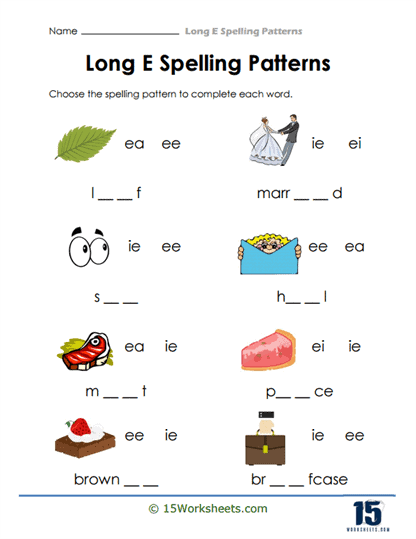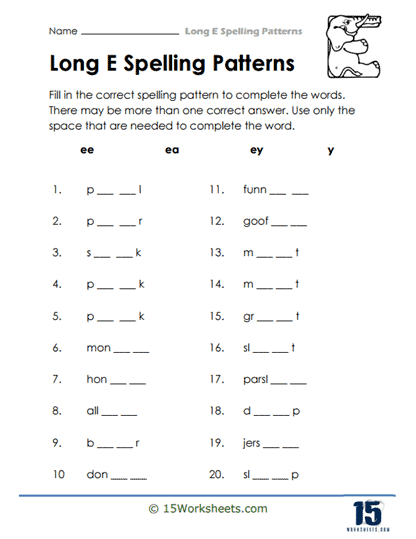Long E Spelling Pattern Worksheets
All About These 15 Worksheets
Long E spelling pattern worksheets serve a foundational role in phonics instruction by helping students understand and internalize one of the most common vowel sounds in English. The long E sound, as heard in words like tree, leaf, and me, is prevalent in everyday language, making it crucial for students to recognize and spell it accurately. These worksheets provide a systematic approach to learning the sound and its spelling variations, guiding students step-by-step through the process of decoding and encoding words with confidence. By isolating and focusing on the long E sound, these worksheets ensure that students build a strong phonemic awareness foundation, a skill critical for successful reading and writing.
The long E sound is a key component of early literacy because it appears frequently in sight words, high-frequency vocabulary, and more complex texts. Mastering this sound equips students to decode many common words, enhancing their reading fluency and comprehension. Furthermore, understanding the various spelling patterns for the long E sound-such as “ee,” “ea,” “e,” “y,” and “ei”-empowers students to tackle more challenging vocabulary as they advance in their learning. Without focused practice on these spelling patterns, students may struggle with spelling inconsistencies and misreading words, which can hinder their confidence and overall literacy development.
These worksheets play an invaluable role in helping educators and homeschoolers deliver structured, consistent instruction. These tools engage students through various activities, such as word matching, fill-in-the-blank exercises, and sentence-building tasks. By providing a blend of repetition and creativity, these worksheets help students internalize the patterns while keeping the learning process enjoyable. For educators, these worksheets also offer flexibility, allowing them to tailor lessons to the needs of individual students or groups. Whether used as a core lesson, a supplemental practice tool, or a quick assessment, long E spelling pattern worksheets help reinforce foundational skills that are essential for long-term literacy success.
The long E sound is unique in its diversity of spelling patterns, making it both essential and challenging for young learners to master. Among the most common patterns are “ee,” as in tree, and “ea,” as in leaf, which often appear in foundational vocabulary for early readers. The single “e,” as in me, introduces students to long vowel sounds in single-syllable words, while the “y” at the end of words like happy demonstrates how consonants can sometimes act as vowels. Additionally, the “ei” pattern, as in ceiling, though less frequent, is an important exception to recognize for spelling and reading fluency. These variations highlight the complexity of English spelling, emphasizing the need for explicit instruction to help students distinguish when and where each pattern is used.
The long E sound in English is represented by several spelling patterns, each with its own common usage and context. The most frequent patterns include “ee,” as in tree or sleep, and “ea,” as in leaf or bread. These two spellings often occur in the middle of words, particularly in simple, monosyllabic words or common vocabulary for early readers. Another common spelling is a single “e,” often found at the end of words, such as me or he, which is most typical in one-syllable words. The “y” spelling, as in happy or baby, is another way the long E sound is represented, usually occurring at the end of multi-syllable words. Less frequently, the long E sound is spelled with “ei,” as in ceiling or receive, or with vowel combinations like “ie,” as in brief, though these tend to follow specific rules and exceptions.
Each spelling pattern has clues that help determine its correct usage. For example, “ee” is often used in words where the sound needs to be sustained, while “ea” is more versatile and can represent either the long E or short E sound depending on the word. The “y” at the end of words often functions as a vowel when no other vowel completes the sound. Meanwhile, “ei” and “ie” are more context-dependent, sometimes guided by general spelling rules like “i before e except after c,” though even this rule has exceptions. Understanding these patterns requires both phonetic awareness and exposure to common words that illustrate their usage. Through systematic practice, students can develop an intuitive sense for when each pattern applies, which enhances their spelling accuracy and reading fluency.
This collection of worksheets were designed to systematically introduce these spelling variations in a clear and engaging way. For example, activities might begin with visual aids showing the different spelling patterns alongside sample words, helping students associate the sounds with their written forms. Tasks like sorting words into categories (e.g., grouping “ee” words and “ea” words) encourage pattern recognition and help students see the connections between similar spellings. By progressively building complexity, these worksheets enable learners to develop a deep understanding of the rules and exceptions for the long E sound. This methodical approach fosters confidence and ensures students don’t become overwhelmed by the range of possibilities.
In addition to recognizing patterns, long E worksheets help students apply their knowledge in context, which is crucial for real-world reading and writing skills. Sentence-completion exercises, for instance, might prompt learners to choose the correct long E spelling based on the meaning of the sentence. Similarly, creative activities such as writing their own sentences using long E words reinforce their understanding while encouraging independent thinking. By combining phonetic clues with contextual analysis, these worksheets prepare students to make accurate spelling choices in their own writing. This dual focus on pattern recognition and contextual application builds a comprehensive skill set that supports literacy development.
Long E spelling pattern worksheets can seamlessly fit into a phonics curriculum, serving as a cornerstone of vowel instruction. Educators can use these worksheets to introduce the concept of the long E sound, providing a structured pathway for students to explore its spelling variations. For example, they can form the basis of a stand-alone lesson where the primary objective is to learn and practice specific patterns such as “ee” or “ea.” These worksheets often include engaging elements such as colorful visuals, rhyming activities, and interactive games, making them a dynamic way to introduce key concepts. By integrating these resources, teachers and homeschoolers can ensure their students develop a solid understanding of vowel sounds in an enjoyable and interactive manner.















